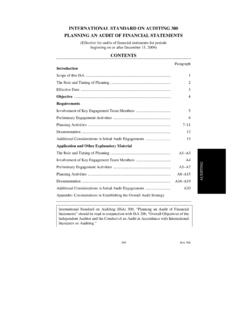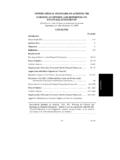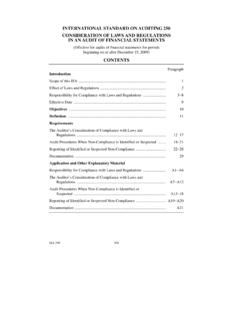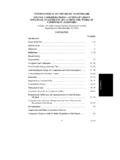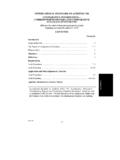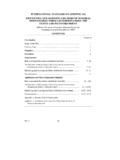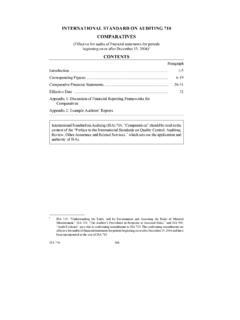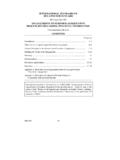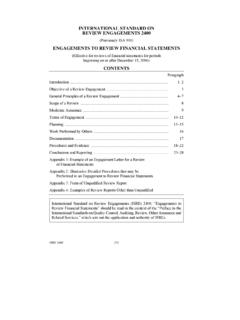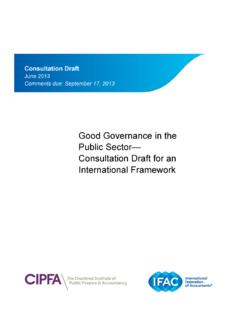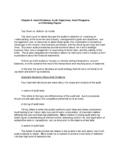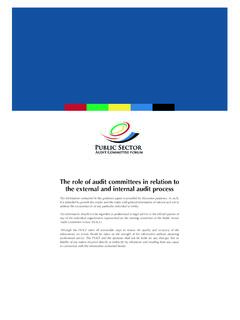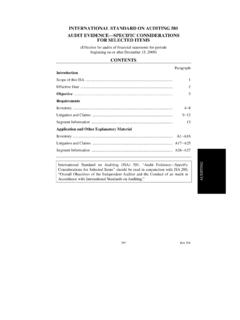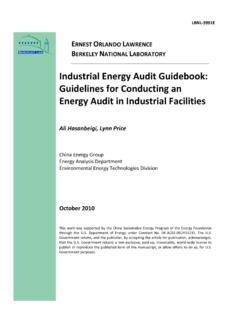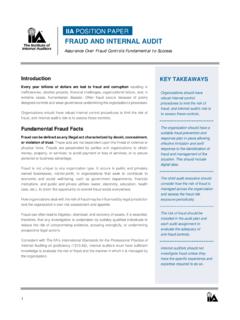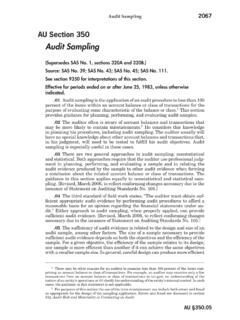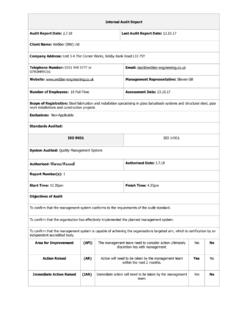Transcription of INTERNATIONAL STANDARD ON AUDITING 500 AUDIT …
1 ISA 500 380 INTERNATIONAL STANDARD ON AUDITING 500 AUDIT evidence (Effective for audits of financial statements for periods beginning on or after December 15, 2009) CONTENTS Paragraph Introduction Scope of this ISA .. 1 2 Effective Date .. 3 Objective .. 4 Definitions .. 5 Requirements Sufficient Appropriate AUDIT evidence .. 6 Information to Be Used as AUDIT evidence .. 7 9 Selecting Items for Testing to Obtain AUDIT evidence .. 10 Inconsistency in, or Doubts over Reliability of, AUDIT evidence .. 11 Application and Other Explanatory Material Sufficient Appropriate AUDIT evidence .. A1 A25 Information to Be Used as AUDIT evidence .. A26 A51 Selecting Items for Testing to Obtain AUDIT evidence .. A52 A56 Inconsistency in, or Doubts over Reliability of, AUDIT evidence .. A57 INTERNATIONAL STANDARD on AUDITING (ISA) 500, AUDIT evidence should be read in conjunction with ISA 200, Overall Objectives of the Independent Auditor and the Conduct of an AUDIT in Accordance with INTERNATIONAL Standards on AUDITING .
2 AUDIT evidence ISA 500 381 AUDITING Introduction Scope of this ISA 1. This INTERNATIONAL STANDARD on AUDITING (ISA) explains what constitutes AUDIT evidence in an AUDIT of financial statements, and deals with the auditor s responsibility to design and perform AUDIT procedures to obtain sufficient appropriate AUDIT evidence to be able to draw reasonable conclusions on which to base the auditor s opinion. 2. This ISA is applicable to all the AUDIT evidence obtained during the course of the AUDIT . Other ISAs deal with specific aspects of the AUDIT (for example, ISA 3151), the AUDIT evidence to be obtained in relation to a particular topic (for example, ISA 5702), specific procedures to obtain AUDIT evidence (for example, ISA 5203), and the evaluation of whether sufficient appropriate AUDIT evidence has been obtained (ISA 2004 and ISA 3305).
3 Effective Date 3. This ISA is effective for audits of financial statements for periods beginning on or after December 15, 2009. Objective 4. The objective of the auditor is to design and perform AUDIT procedures in such a way as to enable the auditor to obtain sufficient appropriate AUDIT evidence to be able to draw reasonable conclusions on which to base the auditor s opinion. Definitions 5. For purposes of the ISAs, the following terms have the meanings attributed below: (a) Accounting records The records of initial accounting entries and supporting records, such as checks and records of electronic fund transfers; invoices; contracts; the general and subsidiary ledgers, journal entries and other adjustments to the financial statements that are not reflected in journal entries; and records such as work sheets and spreadsheets supporting cost allocations, computations, reconciliations and disclosures.
4 1 ISA 315, Identifying and Assessing the Risks of Material Misstatement through Understanding the Entity and Its Environment. 2 ISA 570, Going Concern. 3 ISA 520, Analytical Procedures. 4 ISA 200, Overall Objectives of the Independent Auditor and the Conduct of an AUDIT in Accordance with INTERNATIONAL Standards on AUDITING . 5 ISA 330, The Auditor s Responses to Assessed Risks. AUDIT evidence ISA 500 382(b) Appropriateness (of AUDIT evidence ) The measure of the quality of AUDIT evidence ; that is, its relevance and its reliability in providing support for the conclusions on which the auditor s opinion is based. (c) AUDIT evidence Information used by the auditor in arriving at the conclusions on which the auditor s opinion is based. AUDIT evidence includes both information contained in the accounting records underlying the financial statements and other information.
5 (d) Management s expert An individual or organization possessing expertise in a field other than accounting or AUDITING , whose work in that field is used by the entity to assist the entity in preparing the financial statements. (e) Sufficiency (of AUDIT evidence ) The measure of the quantity of AUDIT evidence . The quantity of the AUDIT evidence needed is affected by the auditor s assessment of the risks of material misstatement and also by the quality of such AUDIT evidence . Requirements Sufficient Appropriate AUDIT evidence 6. The auditor shall design and perform AUDIT procedures that are appropriate in the circumstances for the purpose of obtaining sufficient appropriate AUDIT evidence . (Ref: Para. A1 A25) Information to Be Used as AUDIT evidence 7. When designing and performing AUDIT procedures, the auditor shall consider the relevance and reliability of the information to be used as AUDIT evidence .
6 (Ref: Para. A26 A33) 8. If information to be used as AUDIT evidence has been prepared using the work of a management s expert, the auditor shall, to the extent necessary, having regard to the significance of that expert s work for the auditor s purposes: (Ref: Para. A34 A36) (a) Evaluate the competence, capabilities and objectivity of that expert; (Ref: Para. A37 A43) (b) Obtain an understanding of the work of that expert; and (Ref: Para. A44 A47) (c) Evaluate the appropriateness of that expert s work as AUDIT evidence for the relevant assertion. (Ref: Para. A48) 9. When using information produced by the entity, the auditor shall evaluate whether the information is sufficiently reliable for the auditor s purposes, including, as necessary in the circumstances: (a) Obtaining AUDIT evidence about the accuracy and completeness of the information; and (Ref: Para.)
7 A49 A50) AUDIT evidence ISA 500 383 AUDITING (b) Evaluating whether the information is sufficiently precise and detailed for the auditor s purposes. (Ref: Para. A51) Selecting Items for Testing to Obtain AUDIT evidence 10. When designing tests of controls and tests of details, the auditor shall determine means of selecting items for testing that are effective in meeting the purpose of the AUDIT procedure. (Ref: Para. A52 A56) Inconsistency in, or Doubts over Reliability of, AUDIT evidence 11. If: (a) AUDIT evidence obtained from one source is inconsistent with that obtained from another; or (b) the auditor has doubts over the reliability of information to be used as AUDIT evidence , the auditor shall determine what modifications or additions to AUDIT procedures are necessary to resolve the matter, and shall consider the effect of the matter, if any, on other aspects of the AUDIT .
8 (Ref: Para. A57) ** Application and Other Explanatory Material Sufficient Appropriate AUDIT evidence (Ref: Para. 6) A1. AUDIT evidence is necessary to support the auditor s opinion and report. It is cumulative in nature and is primarily obtained from AUDIT procedures performed during the course of the AUDIT . It may, however, also include information obtained from other sources such as previous audits (provided the auditor has determined whether changes have occurred since the previous AUDIT that may affect its relevance to the current audit6) or a firm s quality control procedures for client acceptance and continuance. In addition to other sources inside and outside the entity, the entity s accounting records are an important source of AUDIT evidence . Also, information that may be used as AUDIT evidence may have been prepared using the work of a management s expert.
9 AUDIT evidence comprises both information that supports and corroborates management s assertions, and any information that contradicts such assertions. In addition, in some cases the absence of information (for example, management s refusal to provide a requested representation) is used by the auditor, and therefore, also constitutes AUDIT evidence . 6 ISA 315, paragraph 9. AUDIT evidence ISA 500 384A2. Most of the auditor s work in forming the auditor s opinion consists of obtaining and evaluating AUDIT evidence . AUDIT procedures to obtain AUDIT evidence can include inspection, observation, confirmation, recalculation, reperformance, and analytical procedures, often in some combination, in addition to inquiry. Although inquiry may provide important AUDIT evidence , and may even produce evidence of a misstatement, inquiry alone ordinarily does not provide sufficient AUDIT evidence of the absence of a material misstatement at the assertion level, nor of the operating effectiveness of controls.
10 A3. As explained in ISA 200,7 reasonable assurance is obtained when the auditor has obtained sufficient appropriate AUDIT evidence to reduce AUDIT risk (that is, the risk that the auditor expresses an inappropriate opinion when the financial statements are materially misstated) to an acceptably low level. A4. The sufficiency and appropriateness of AUDIT evidence are interrelated. Sufficiency is the measure of the quantity of AUDIT evidence . The quantity of AUDIT evidence needed is affected by the auditor s assessment of the risks of misstatement (the higher the assessed risks, the more AUDIT evidence is likely to be required) and also by the quality of such AUDIT evidence (the higher the quality, the less may be required). Obtaining more AUDIT evidence , however, may not compensate for its poor quality. A5. Appropriateness is the measure of the quality of AUDIT evidence ; that is, its relevance and its reliability in providing support for the conclusions on which the auditor s opinion is based.
